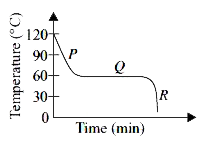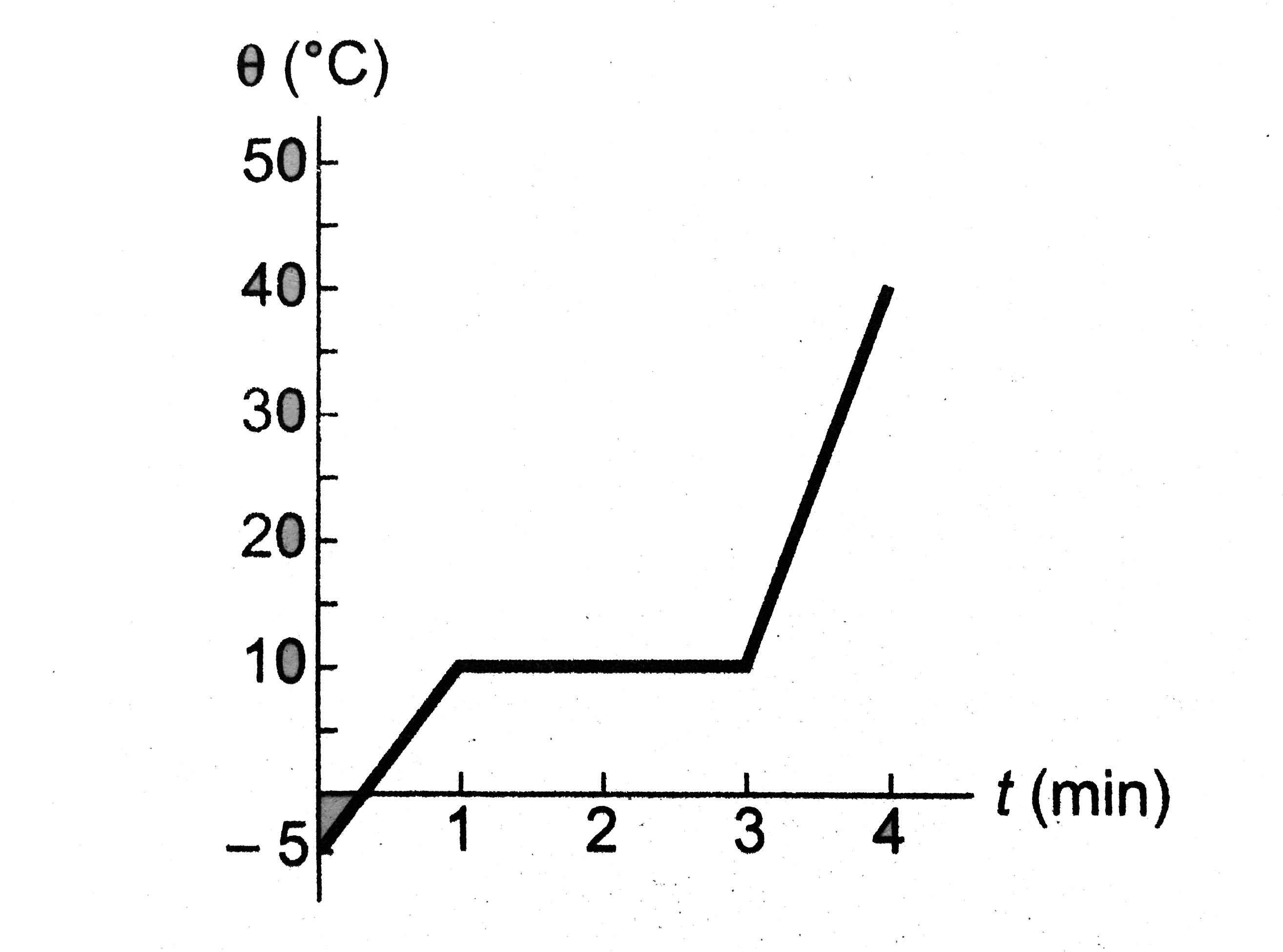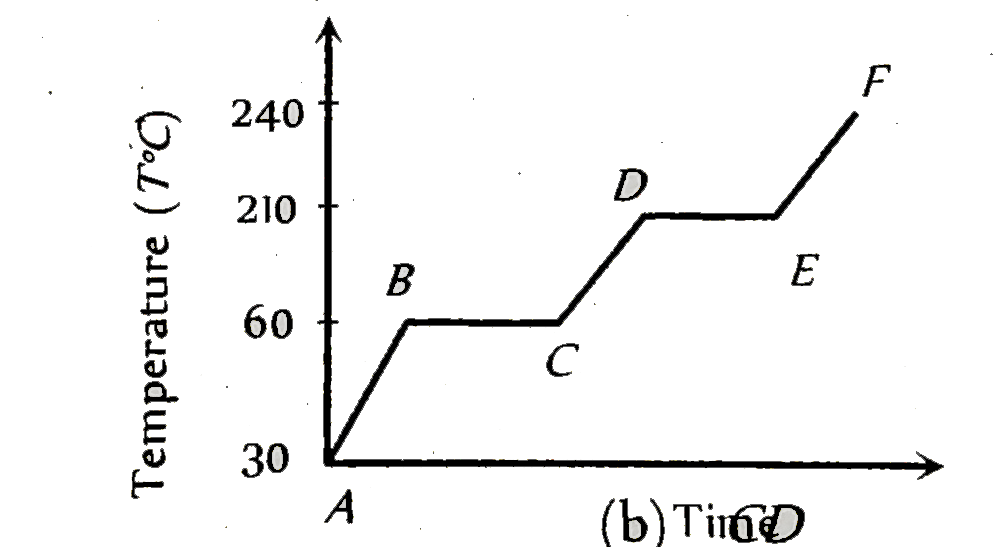Dhairya, a Class 9 student heated a solid 'X' beyond its melting point. Then, he allowed the hot liquid to cool slowly and recorded the temperature at regular time intervals until it cooled to 20∘C. He obtained the given cooling curve.

The parts of graph where 'X' exists in solid state, in liquid state and in both solid and liquid states are respectively
Q, P and R
P, Q and R
R, P and Q
R, Q and P
The correct Answer is:C
Step by step video, text & image solution for Dhairya, a Class 9 student heated a solid 'X' beyond its melting point. Then, he allowed the hot liquid to cool slowly and recorded the temperature at regular time intervals until it cooled to 20^(@)C. He obtained the given cooling curve. The parts of graph where 'X' exists in solid state, in liquid state and in both solid and liquid states are respectively by Physics experts to help you in doubts & scoring excellent marks in Class 9 exams.
Updated on:21/07/2023Topper's Solved these Questions
- NSO QUESTION PAPER 2016 SET BBOOK - SCIENCE OLYMPIAD FOUNDATION CHAPTER - NSO QUESTION PAPER 2016 SET BEXERCISE - ACHIEVERS SECTION
2 Videos
- NSO QUESTION PAPER 2016 SET A BOOK - SCIENCE OLYMPIAD FOUNDATION CHAPTER - NSO QUESTION PAPER 2016 SET A EXERCISE - ACHIEVERS SECTION
2 Videos
- NSO QUESTION PAPER 2017 SET A BOOK - SCIENCE OLYMPIAD FOUNDATION CHAPTER - NSO QUESTION PAPER 2017 SET A EXERCISE - ACHIEVERS SECTION
1 Videos
Similar Questions
Knowledge Check
A substance 'X' having low melting point, does not conduct electricity in both solid and liquid state. 'X' can be :
AHgBZnSCSiCDCl4X’ melts at low temperature and is a bad conductor of electricity in both liquid and solid state. X is:
ACarbon tetrachlorideBSilicon carbideCZinc sulphideDMercuryA given substance of mass 'm' is in solid state at certain temperature. Arrange the following steps in proper sequence to calculate the total heat energy required to just convert the substance completely into gaseous state.
(A) Note down the specific latent heat of vapor ization of the substance and calculate the heat supplied to convert from liquid to gaseous state using the formula.
(B) Note down the melting point of the substance and calculate the heat supplied to increase the temperature of the solid to its melting point.
(C ) Note down the boiling point of the substance and calculate the heat supplied to increase the temperature of the substance from melting point to its boiling point.
(D) Add all the heat energies, it gives the resultant heat supplied to the solid to just convert it into gaseous state.
(E) Note down the specific latent heat of fusion of the substance and calculate the heat supplied to convert the substance from solid state to liquid state.AB D E C ABA C E D BCA B C D EDB E C A D
As a physicist, you put heat into a 500 g solid sample at the rate of 10.0kJ/min, while recording its temperature as a function of time. You plot your data and obtain the graph shown in figure.
 .
.
(a) What is the latent heat of fusion for this solid?
(b) What is the specific heat of solid state of the material?
View SolutionA ginven substance of mass 'm' is in solid state at certain temperature. Arrange the following steps in proper sequence to calcualte the total heat energy required to just convert the substance completely into gaseous state.
(a). Note down the specific latent heat of vaporization of the substance and calculate the heat supplied to convert from liquid to gaseous state using the formula.
(b) Note down the melting point of the substance and calculate the heat supplied to increase the temperature of the solid to its melting point.
(c) Note down the boiling point of the substance and calculate the heat supplied to increase the temperature of the substance from melting point to its boiling point.
(d). Add all the heat energies, it gives the resultant hea supplied to the solid to just convert it into gaseous state.
(e) Note down the specific latent heat of fusion of the substance and calculate the heat supplied to convert the substance from solid state to liquid state.
View SolutionA solid substance is at 30∘C . To this substance heat energy is supplied at a constant rate. Then temperature versus time graph is as shown in the figure. The substance is in liquid state for the portion (of the graph)

View SolutionConsider the following statement(s).
I. The amount of heat required to change 1 kg solid into liquid at atmospheric pressure and at its melting point is called the latent heat of fusion.
II. The phenomenon of change of a liquid into vapours at any temperature below its boiling point called sublimation.
III. The process of conversion of a liquid into its vapour is called boiling.
IV. The process of converting solid into gaseous state is called evaporation.
Which of the above statement(s) given above is/are correct?
View SolutionConsider the following statement(s).
The amount of heat required to.. change 1 kg solid into liquid at atmospheric pressure and at its melting point is called the latent heat of fusion.
II. The phenomenon of change of a liquid into vapours at any temperature below its boiling point called sublitnation.
III. The process of conversion of a liquid into its vapour is called boiling.
IV . The process of converting solid into gaseous state is called evaporation .
Which of the above statement(s) given above is/are correct?
View Solution
